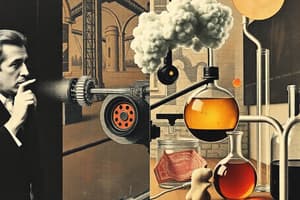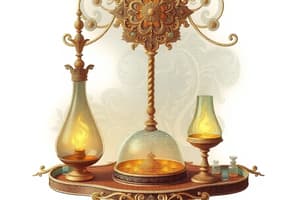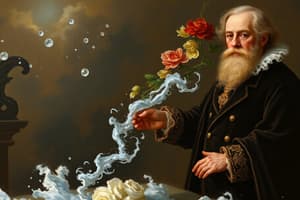Podcast
Questions and Answers
What fuel gas is often considered the best choice for soldering?
What fuel gas is often considered the best choice for soldering?
- Hydrogen
- Butane
- Propane (correct)
- Acetylene
The hottest part of the flame should be used to heat the soldering assembly.
The hottest part of the flame should be used to heat the soldering assembly.
False (B)
During investment soldering, the indexed assembly is mounted in a soldering __________ which hardens and holds the parts together.
During investment soldering, the indexed assembly is mounted in a soldering __________ which hardens and holds the parts together.
investment
What is the most common instrument for applying heat in soldering?
What is the most common instrument for applying heat in soldering?
What are the parent metals in soldering also known as?
What are the parent metals in soldering also known as?
Flashcards
Flame for Soldering
Flame for Soldering
The portion of the flame used to heat the soldering assembly should be the tip of the reducing zone.
Fuel Gases
Fuel Gases
Propane and Butane are pure compounds that burn cleanly when the torch flame is adjusted properly.
Soldering
Soldering
Joining metals by fusion of an intermediary alloy with a lower melting point that fills the gap between them using molten metal below 450°C.
Parent Metals
Parent Metals
Signup and view all the flashcards
Flux
Flux
Signup and view all the flashcards
Study Notes
Gas Properties
- Gases are highly compressible
- The volume of a gas varies with container size
- Gases expand to fill their container
- Gases form homogeneous mixtures
Pressure
- Pressure is defined as force per unit area: $P = \frac{F}{A}$
- The SI unit for pressure is the Pascal (Pa): $1 Pa = 1 N/m^2$
- Other units for pressure include mmHg, torr, atm, and kPa
- Conversions: $1 atm = 760 mmHg = 760 torr = 1.01325 \times 10^5 Pa = 101.325 kPa$
Boyle's Law
- States that volume is inversely proportional to pressure at constant temperature and number of moles: $V \propto \frac{1}{P}$
- Formula: $P_1V_1 = P_2V_2$
Charles's Law
- States that volume is directly proportional to temperature at constant pressure and number of moles: $V \propto T$
- Formula: $\frac{V_1}{T_1} = \frac{V_2}{T_2}$
Avogadro's Law
- States that volume is directly proportional to the number of moles at constant temperature and pressure: $V \propto n$
- Formula: $\frac{V_1}{n_1} = \frac{V_2}{n_2}$
Ideal-Gas Equation
- Relates pressure, volume, number of moles, and temperature: $PV = nRT$
- $R$ is the ideal gas constant, with values of $0.08206 \frac{L \cdot atm}{mol \cdot K}$ or $8.314 \frac{J}{mol \cdot K}$
Standard Temperature and Pressure (STP)
- Defined as $0^\circ C$ (273.15 K) and 1 atm
- The molar volume of an ideal gas at STP is 22.41 L
Gas Density
- Can be calculated using the formula: $d = \frac{m}{V} = \frac{MP}{RT}$, where $M$ is molar mass
Molar Mass
- Can be calculated using the formula: $M = \frac{dRT}{P}$
Dalton's Law of Partial Pressures
- States that the total pressure of a gas mixture is the sum of the partial pressures of each component: $P_t = P_1 + P_2 + P_3 +...$
Partial Pressure
- Defined as the mole fraction of gas $i$ times the total pressure: $P_i = X_i P_t$
- Mole fraction is defined as: $X_i = \frac{n_i}{n_t}$
Gas Stoichiometry
- The ideal-gas equation can be used to relate volume, pressure, temperature, and moles in chemical reactions.
Kinetic-Molecular Theory of Gases : Postulates
- Gases consist of particles in continuous, random motion.
- The volume of gas particles is negligible compared to the total volume.
- Attractive/repulsive forces between particles are negligible.
- Average kinetic energy is proportional to absolute temperature.
- Collisions are elastic (energy can be transferred, but total energy remains constant).
Average Kinetic Energy
- The formula for calculating average kinetic energy: $\bar{KE} = \frac{3}{2}RT$
Root-Mean-Square (rms) Speed
- The formula for calculating rms speed: $u = \sqrt{\frac{3RT}{M}}$
Effusion
- The escape of gas molecules through a tiny hole.
Graham's Law
- States that the rate of effusion or diffusion is inversely proportional to the square root of the molar mass: $\frac{r_1}{r_2} = \sqrt{\frac{M_2}{M_1}}$
Diffusion
- The spread of one substance through another.
Real Gases
- Deviate from ideal behavior at high pressure and low temperature
van der Waals Equation
- Corrects ideal gas behavior for real gases: $(P + \frac{an^2}{V^2})(V - nb) = nRT$
- $a$ corrects for intermolecular attractions
- $b$ corrects for the volume of gas molecules
Radiative Heat Transfer
- Heat transfer occurs by conduction, convection, and radiation.
- Conduction is energy transfer through particle interaction within a substance.
- Convection is energy transfer between a solid surface and a moving fluid.
- Radiation is energy emitted as electromagnetic waves due to changes in electronic configurations.
- Conduction and convection require a medium.
Radiation does not
- Radiation doesn't need a medium
- Radiation travels at the speed of light in a vacuum.
- All bodies at a temperature above absolute zero emit thermal radiation.
Blackbody Radiation
- Blackbody is a perfect emitter and absorber of radiation.
- Blackbody emits maximum energy at a given temperature and wavelength.
- Blackbody absorbs all incident radiation.
Blackbody Emissive Power
- Blackbody emissive power: $E_b(T) = \sigma T^4$
- $\sigma = 5.67 \times 10^{-8} W/m^2 \cdot K^4$: Stefan-Boltzmann constant $T$: absolute temperature in Kelvin (K)
Emissivity
- Emissivity represents how close a surface is to a blackbody. Denoted by $\epsilon$.
- Emissivity ranges between between 0 and 1: ($0 \le \epsilon \le 1$)
- Blackbodies have an emissivity of 1.
Molecular Orbitals
LCAO
- Molecular orbitals are approximated by linear combinations of atomic orbitals
- $$\phi = \sum_{i}^{n}c_i\chi_i$$
- $\phi$: molecular orbital
- $\chi_i$: atomic orbitals
- $c_i$: coefficients
- $n$: number of atomic orbitals
$\mathrm{H}_2^+$: Schrödinger equation
- The schrödinger equation $\hat{H}\psi = E\psi$
- Can also be written as: $\left(-\frac{\hbar^2}{2m}\nabla^2 + V \right)\psi = E\psi$
$\mathrm{H}_2^+$
- The schrödinger equation: $$\left(-\frac{\hbar^2}{2m}\nabla^2 - \frac{e^2}{4\pi\epsilon_0r_A} - \frac{e^2}{4\pi\epsilon_0r_B} + \frac{e^2}{4\pi\epsilon_0R} \right)\psi = E\psi$$
Born-Oppenheimer approximation
- Nuclear kinetic energy is negligible compared to that of the electron
Trial wave function
- $$\psi = c_A\chi_A + c_B\chi_B$$
- $\chi_A$: 1s orbital on atom A
- $\chi_B$: 1s orbital on atom B
Secular equation
$$\begin{vmatrix} H_{AA} - ES_{AA} & H_{AB} - ES_{AB} \ H_{BA} - ES_{BA} & H_{BB} - ES_{BB} \end{vmatrix} = 0$$
Secular determinant
$$H_{ij} = \int \chi_i^* \hat{H} \chi_j d\tau$$
$$S_{ij} = \int \chi_i^* \chi_j d\tau$$
Energy levels
$$E_{\pm} = \frac{H_{AA} \pm H_{AB}}{1 \pm S_{AB}}$$
- $H_{AA} = H_{BB} = \int \chi_A^* \hat{H} \chi_A d\tau$ : Coulomb integral
- $H_{AB} = H_{BA} = \int \chi_A^* \hat{H} \chi_B d\tau$ : Resonance integral
- $S_{AB} = \int \chi_A^* \chi_B d\tau$ : Overlap integral
Wave functions
$$\psi_+ = \frac{1}{\sqrt{2 + 2S_{AB}}}(\chi_A + \chi_B)$$
$$\psi_- = \frac{1}{\sqrt{2 - 2S_{AB}}}(\chi_A - \chi_B)$$
Bonding and Antibonding Orbitals
- $\psi_+$: bonding orbital
- $\psi_-$: antibonding orbital
1s$\sigma_g$ and 1s$\sigma_u^*$
- $\sigma$: $\lambda = 0$ cylindrically symmetrical around the internuclear axis
- g: gerade, symmetric with respect to inversion through the center of the molecule
- u: ungerade, antisymmetric with respect to inversion through the center of the molecule
- * : antibonding
Studying That Suits You
Use AI to generate personalized quizzes and flashcards to suit your learning preferences.




